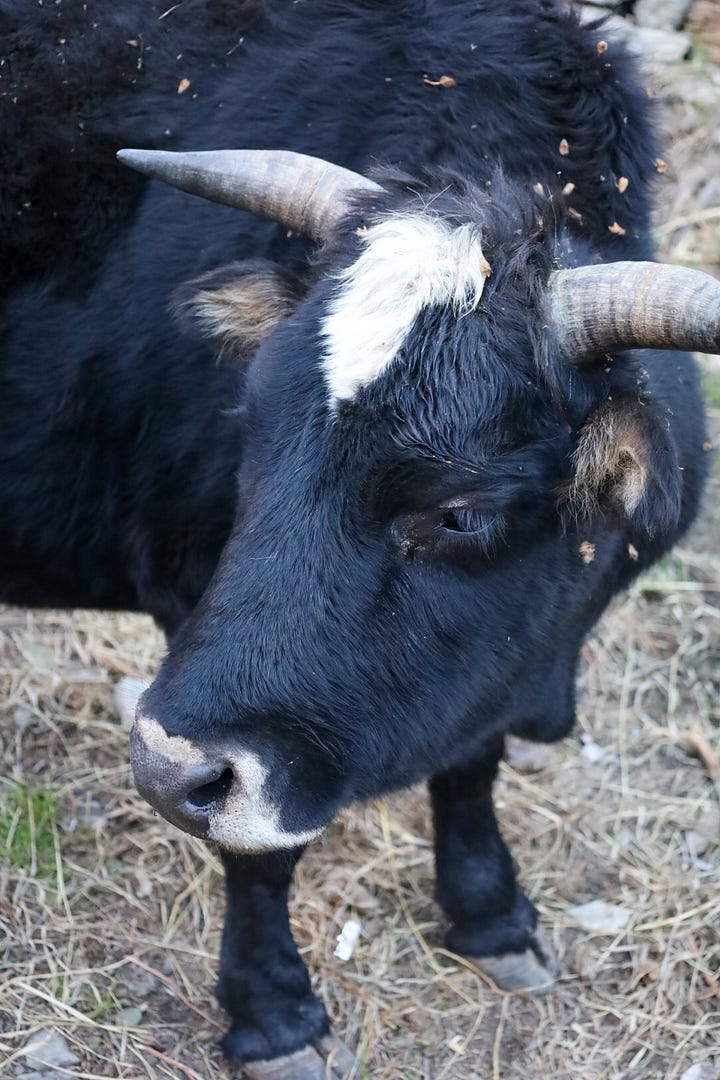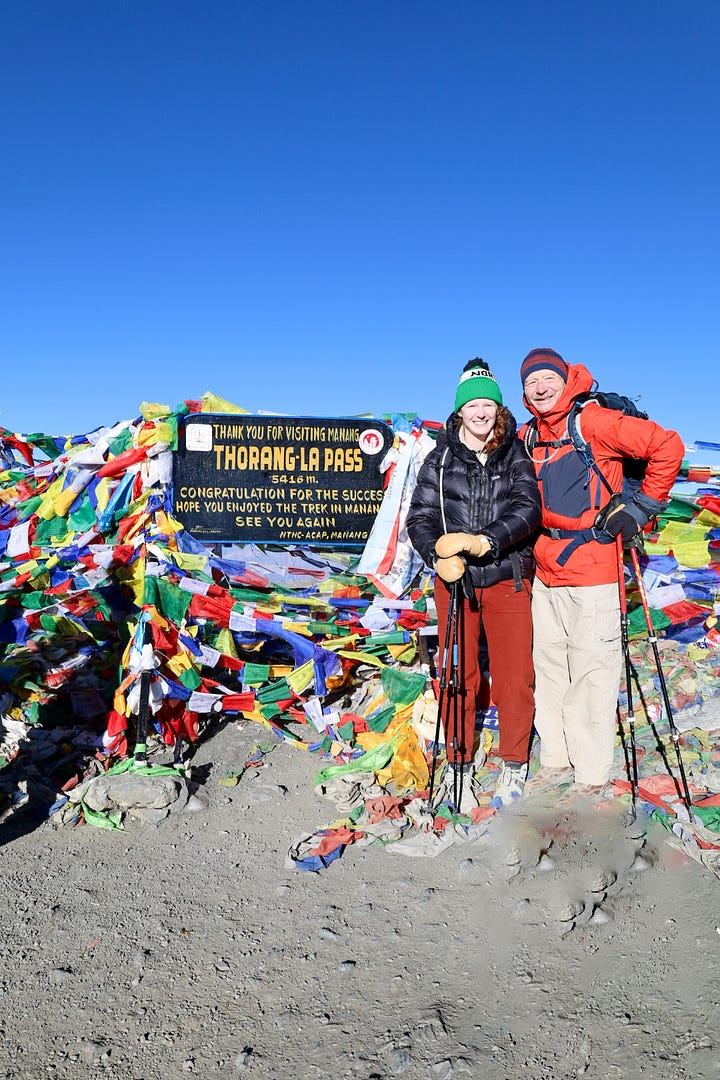The last stop on my sabbatical world tour was a two week hike of the Annapurna Circuit in Nepal. Doing a big trek in Nepal was a bucket-list item for me, and because I was still feeling unsure about whether my knee could hold up over a two week backpacking trip, I decided to make Nepal my last stop on the travel journey, to give myself more time to strengthen and recover.
My Dad also decided to join me on this leg of the trip, despite never really having done any backpacking.




As of April 2023, you’re now required to bring a guide for the vast majority of the treks in Nepal. This seems to be more motivated by trying to bring tourism dollars into the country than any real difficulty in following the trail or booking accommodation, but we decided to go with the flow and signed up for a trip with the Nepal Hiking Team.
Overall, we did about 90 miles of distance over the course of 10 days of hiking (plus another 10-15 of acclimatization hikes), with a couple of days for transport in and out, totaling a 14 day trip. Technically the entire Annapurna Circuit is about 161 miles, but we completed the most commonly hiked section, beginning in Jagat, and ending in Jomsom.
When we arrived, a number of people asked me how I chose Annapurna vs. Everest Base Camp or another famous Nepalese hike. Honestly, I didn’t put too much thought into it - I had heard some mixed things about EBC itself (including that it’s full of trash and with the receding glacier that it’s getting less pretty) and Annapurna actually goes a bit higher than EBC, crossing the highest pass in the world, Thorong La, which seemed exciting! I loved Annapurna for the variety of terrain we got to see, but I do think EBC would also be incredible, especially if you add an additional day or two so that you can see Everest itself (you can’t see it from EBC). So, there I was, setting off on a big hike!



One of the luxuries of the major Nepalese treks is that each night you stay in a “teahouse” which enables you to skip the carrying and setup of a tent each night, as well as the carrying and cooking of your food. Most guest houses only cost a few dollars to stay as long as you eat two meals with them (dinner and breakfast). While imagining these teahouses I was expecting giant rooms full of bunk beds, dirty shared toilets, and daal for every meal. In reality, the majority of our accommodations were much nicer than I expected. Most teahouses had rooms shared with 1 or 2 other people, some with attached private bathrooms (though primarily squat toilets), and all had significant menus with a range of Nepalese and western options. A couple of them even had hot showers — though I will say that it was so cold getting out of the shower and getting dressed again given that everything was unheated that I nearly never took advantage. Moreover, each teahouse had a main dining room with a big potbelly stove that was lit as the sun went down and served as a warming and congregation place for everyone staying there. Typically if you were in your room you had to be inside your sleeping bag to stay warm enough, so the dining area each night was a lovely community of people playing cards, reading, or just rotating through spots by the fire.


Given how my knee has been over the past year, I was certainly nervous about how I was going to fair physically. In the end, the hiking aspect of the trek was a lot easier than I expected, but the altitude ended up much tougher. I’ve hiked a few 14ers before and have skiied at some high altitudes, so I thought I was prepared for the slight headache and low brain power that can come with the height. What I had not thought through, however, was that because the pass was at 17,769 ft, that means we were sleeping above 12,000 ft for the 3 nights ahead of that day. We slept at about 12,500 ft, then 13,500 ft, then 14,500 ft, before then hiking up over 3,000 ft and then down over 5,000 ft in one day. For me, once we were over that 12,000 ft point, I slept much less well, despite having long days of hiking, and I lost my appetite significantly. At 14,500 I tried to read a book and after a few minutes realized I had just been staring at the page reading the same words over and over again for 5 minutes. So though the vertical and distance would have been a solid day anyway, I felt like we were doing that day after essentially not sleeping for 2-3 nights and eating probably less than 1,000 calories for the prior 2-3 days. This was all while also on Diamox, a medication you can take to prevent acute mountain sickness (which theoretically made the symptoms less intense).
For the unfortunate majority of others on the trip (including my Dad) the altitude was the least of their worries. The day before our pass day about 2/3 of our group came down with a really nasty bout of food poisoning. People were struggling to keep down fluids, dehydration exacerbated by the fact that we were up so high and they should have been hydrating even more than usual. It was a super tough 24-48 hours for the group as a whole, but somehow we rallied together and everyone made it across the pass.
Go on a high altitude trek, they said. It’ll be fun, they said!
Just kidding. Even with all of these setbacks, it was an absolutely incredible trip.
It’s hard to describe the sheer scale of the mountains at that height. The intensity of the cold. The deep spirituality and community of the temples, the shouts of ‘Namaste’ from kids playing on the rooftop terraces of their homes.




The pass day itself was spectacular. We started hiking at about 4 am, when it was still fully dark. I think the darkness is part of what made the day seem easier to me — in the darkness you can’t tell how far you’ve come or how far you have to go. It helped keep me focused on just putting one foot in front of another. We hiked up and up, watching little rows of headlamps bob up and down both in front of us and behind. We watched the sky warm and then the sun come up over the mountains. We rounded corner after corner expecting to be able to see the pass and finding just another sheet of rock and ice. But then we rounded the final corner and saw a small yellow tent-like structure that was close to the top of the pass. In retrospect, I still don’t actually know what that tent was as we couldn’t see it from the pass itself. I ate a squashed Mars bar from my pocket that I had thought was a Snickers and was disappointed to find was peanut-free. We crossed the highest mountain pass in the world.
Moreover, I was touched to be able to share this experience with my Dad, for a variety of reasons. First and most simply, it’s by far the longest stretch of one-on-one time that we’ve had, maybe ever. As I’ve gotten older, and particularly after moving abroad, every time I see my family it feels jam packed with people - parents and siblings and partners and now a very cute niece. It was lovely, both during my trip with my sister and this one with my Dad, to be able to get a long stretch of one-on-one time. Secondly, the trip definitely stretched many people on our trek to their limits, including (and I think he’d agree with me on this) my Dad. One thing I’ve been reflecting on recently is that only by living at my edge have I been able to make progress. I think about worries or stresses as a line with two points on the end. If the middle is my comfort zone, then the two points are the edges of my comfort zone. I’ve pushed those limits before, but usually that means just edging the dot out a bit. By moving to Nigeria I feel like I completely moved the dot to the other side of the page. The things that used to be near that point that might worry me, now are so close to the middle that they don’t even register. I’ve dramatically expanded my comfort zone. I think that’s one of the reasons why I was also able to have such a great time solo traveling, as that’s likely something that I would have been more anxious about in the past. Watching my Dad push his comfort zone, and being able to support him while he did that was a great privilege and opportunity. It’s inspiring to watch people be capable of things they didn’t think they were. It reminds me that that is true for me too.



